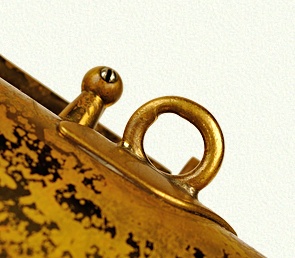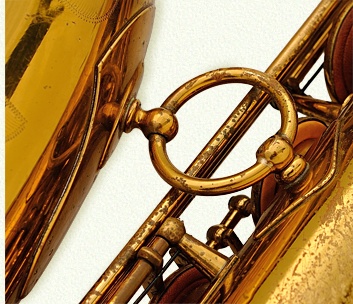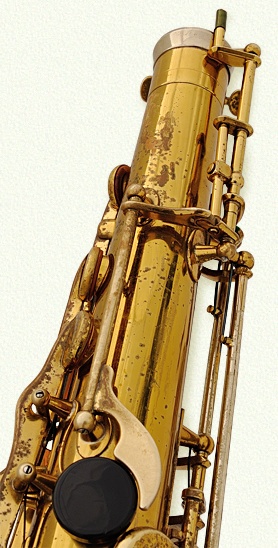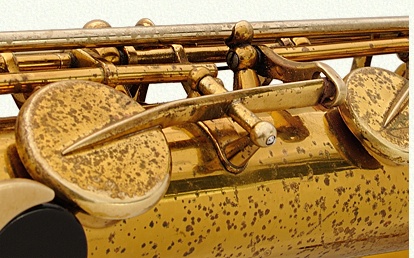Selmer MkVI tenor saxophone
 Origin:
France Origin:
France
Guide price: Various from £2000
Weight: 3.15kg
Date of manufacture: 1954-1974 (example reviewed - 1962)
Date reviewed: February 2015
'The' saxophone
At the opening of my review of the
Selmer MkVI alto I hinted at some trepidation on the basis that
this horn was, and still is, something of a legend. I knew from
the off that no matter what I said, someone was bound to be upset
- and there was a lot that needed to be said.
In approaching the tenor review I find myself
reprising those anxieties - though this time it's perhaps a little
more personal.
Y'see - to my mind, the Selmer Mark 6 (MkVI) tenor is the archetypal
saxophone. That's not to say that it's the best, nor even the most
important - it's just the horn around which the most mystique and
rumour has flown. Most of it's nonsense - but some of it carried
enough weight to make this horn the definitive professional model
for all of its 20 year run...and, for many players, right through
to today. Whether you're fan of the marque or not, you have to admit
it's an impressive achievement.
I've spent most of my professional career attending
to the whims and foibles of these noble horns - not to mention the
whims and foibles of many of their owners...some less noble than
others...and over those long years I like to think I've built up
something of a relationship with this unique and endearing horn.
And 'relationship' is a very apt word because, more than any other
marque, Selmer MkVI owners often talk about their horns in much
the same way that people talk about their partners. There's often
a story about how they met, how long they've been together, the
trials they've been through - and, on occasion, how they've sometimes
been tempted (and even succumbed) to try other horns but have always
returned to their 'one true love'.
Even those players who've found a new love in their playing life
will often speak of their old MkVI with genuine affection.
I've always liked a good MkVI tenor - but, and
this is important, I've never liked one enough to want to own one.
So while I have a great deal of respect and admiration for this
particular instrument, I'm also not so smitten that I can't see
through the sultry charms that hide the inevitable compromises that
all saxes suffer from.
In this respect I hope it means that I can provide a balanced perspective,
as I always try to do.
We shall see...
It's a common misconception that this horn was
revolutionary. It was not - it was a product of evolution. Just
ask any player who owns either the Super Action (or, as it's more
commonly known, the Super Balanced Action or SBA), which preceded
the MkVI - or the Balanced Action, or BA, which preceded the SBA.
It might help to think in terms of a growing child; Selmer's early
models would cover the years from birth to early teens - and adolescence
begins with the BA. The SBA covers late teens...the beginnings of
maturity, and the MkVI represents 'the coming of age', when the
21st birthday is marked. It's not the same as what came before,
but it is...if you get my drift.
And Selmer came of age in 1954, when the first
MkVI rolled off the production line.
From the SBA before it, the MkVI inherited a raft
of modern features; ribbed construction, a detachable bell, a distinctive
circular bell brace, a swivelling octave key mech, offset key stacks,
adjusters on the Bis Bb/G# and a set of adjustable bell key guards.
In terms of build quality the body was very well put together. Individual
pillar bases were of a good size, the soldering was neat and tidy
and the attention to detail remained pretty good throughout its
build life.
 The
body also boasted a few improvements, such as an adjustable metal
(later plastic) thumb hook and a large flat (though plastic) thumb
rest - and there were, of course, tweaks to the ergonomics and to
the bore/toneholes. The
body also boasted a few improvements, such as an adjustable metal
(later plastic) thumb hook and a large flat (though plastic) thumb
rest - and there were, of course, tweaks to the ergonomics and to
the bore/toneholes.
It also inherited the lousy sling ring (oh well, at 21 I guess you
still have a few zits). It's small, and thin, and if I had a pound
for every time I'd had to build up a worn ring with silver solder
or flip the ring 180 degrees, I'd have £73.50. We don't talk
about the 50p one...
To be fair, the MkVI wasn't the only horn to be plagued by chewed
sling ring syndrome - and to be even fairer there simply weren't
any nylon sling hooks around back then. Even a decent one was just
a non-locking hook with (if you were lucky) a bit of plastic tube
over it...which split and fell off after about twelve gigs.
Worse still were those rudimentary locking clips, made from square-section
steel (often used for shoulder straps on bags), which could eat
their way through a brass sling ring in less than a couple of years.
If your sling ring looks anything like this one, it's worth getting
it sorted as soon as you can. It's not an expensive job - whereas
sorting out the damage to a horn that's fallen off its sling most
definitely is.
The circular bell brace was something of a radical
design statement in its day. For a start, it was removable...or
at least partially so. The bell side is fixed to its stay but the
body side is held on with a bolt. This, coupled with the detachable
bottom bow joint, made it relatively easy for repairers to take
the bell off the body in the event of either section requiring repairs
due to severe impact damage. Whether this feature was designed with
repairers in mind or as a means of speeding up and cutting the cost
of production, we may never know. Maybe a bit of both.
 The
ring is offset, and this too was a neat feature. A great many horns
of the period had simple, fixed bell braces which were fitted more
or less in line with the bell. With the body stay being placed in
amongst the lower stack toneholes, a hefty impact would often drive
the stay into the body - putting a large dent into it and distorting
the surrounding toneholes. The ring brace diverts the force of the
impact to the side of the body tube, making any damage that much
easier to repair. The ring itself is also able to absorb an impact,
and it's not uncommon to see an old Selmer with a slightly oval
ring (as this one is). It's not a major problem - it's quite possible
to set the bell keys up to accommodate a small amount of distortion
in the ring, and it's equally possible to have the ring rounded
out again (there are special tools just for this job). The
ring is offset, and this too was a neat feature. A great many horns
of the period had simple, fixed bell braces which were fitted more
or less in line with the bell. With the body stay being placed in
amongst the lower stack toneholes, a hefty impact would often drive
the stay into the body - putting a large dent into it and distorting
the surrounding toneholes. The ring brace diverts the force of the
impact to the side of the body tube, making any damage that much
easier to repair. The ring itself is also able to absorb an impact,
and it's not uncommon to see an old Selmer with a slightly oval
ring (as this one is). It's not a major problem - it's quite possible
to set the bell keys up to accommodate a small amount of distortion
in the ring, and it's equally possible to have the ring rounded
out again (there are special tools just for this job).
The detachable bell can be something of a double-edged
sword inasmuch as the bottom bow joint often gets a bit leaky over
time. It would have been sealed originally, but with many of these
horns getting on for 50+ years old, the seal will have broken down.
At best this leads to a loss of power and response in the bell notes
- at worst it can lead to near complete failure of the notes below
low C.
It's easy enough to fix - a workable (and cheap) solution is to
remove the joint clamp ring and wrap the joint face with PTFE tape
and refit the ring over it, but the best bet is to have the bell
section taken off and a suitable sealant applied to the joint faces
before reassembly.
If you suspect your bottom bow joint might be leaking you can wrap
some PTFE (plumbers) tape or clingfilm over the clamp. This'll seal
it up for at least as long as it takes you to test whether the bell
notes play any better, and it's easy to remove when you're done.
Speaking of bottom bows, while Selmer experimented
with the dimensions of the bottom bow on the alto, the tenor was
progressively tweaked at the other end - with several changes made
to the bore of the crook throughout its run. The first models had
the narrowest bore - noticeably smaller than the preceding SBA series
- and as the years passed the bore got wider and wider. How this
affected the playability of the horn is open to (much) debate, but
the general consensus seems to be that the earlier the model, the
more 'introspective' it's likely to be - and the later the model,
the more 'brash'. However, I wouldn't use that as any kind of guideline
when seeking out a MkVI tenor simply because of the variability
between individual examples. I've played as many bright and punchy
late '50s examples as I have mellow late '60s models.
 As
well as the body tweaks, the keywork also had a refresh over the
earlier SBA, and one of the most important was the redesign of the
octave key mechanism. The essential part (the swivelling mech) remained
much the same, but the touchpiece was made broader and flatter -
along with its accompanying thumb rest. The touchpiece was also
offset to the right, which offered players more choices when it
came to hitting the high notes - with many players finding it a
great deal easier being able to push the thumb forward rather than
have to roll it upwards to operate the mech. As
well as the body tweaks, the keywork also had a refresh over the
earlier SBA, and one of the most important was the redesign of the
octave key mechanism. The essential part (the swivelling mech) remained
much the same, but the touchpiece was made broader and flatter -
along with its accompanying thumb rest. The touchpiece was also
offset to the right, which offered players more choices when it
came to hitting the high notes - with many players finding it a
great deal easier being able to push the thumb forward rather than
have to roll it upwards to operate the mech.
It's generally a very reliable mech, though the long rod screw which
runs through the swivel section is prone to knocks, and the whole
thing tends to get rather rattley when it wears. Fortunately it's
a reasonably easy job to overhaul the mech - and a common modern
upgrade is to fit Teflon tubes to the pivot points on the swivel.
This quietens the mech and makes it smoother in operation - and
many modern swivelling mechs are built this way as standard.
Another source of noise is the loss of buffering between the connection
from the touchpiece lever to the swivel, as well as wear in the
point screws on which the touchpiece lever pivots. Again, these
are simple problems to correct but it certainly never hurts to keep
the whole mech well lubricated. Even on a worn mech, a drop of decent
oil will quieten it down by 50%.
Another concession to ergonomics was the introduction
of the tilting table on the bell key cluster.
I've always been in two minds about this feature - but then I cut
my chops on horns that had non-titling bell keys...so maybe I just
got used to the idea.
 Perhaps
the biggest drawback of the tilting table is that its position makes
it very prone to damage from knocks - and because of the interconnectivity
it often means that rather than one key being knocked out of alignment,
the whole mech seizes up. Perhaps
the biggest drawback of the tilting table is that its position makes
it very prone to damage from knocks - and because of the interconnectivity
it often means that rather than one key being knocked out of alignment,
the whole mech seizes up.
Like the octave mech, the tilting table tends to get a bit noisy
over time. Most of this is down to losing the buffering on the pin
that extends off the low C# touchpiece and sits within the u-section
connection to the low Bb touchpiece - but wear in the Bb touchpiece
pivot is also a major source of rattles. Like the octave mech, keeping
it well lubed helps, including a drop of oil on the rollers from
time to time.
The compound pillar (on which the bell keys are
mounted) separates the low C#/B/Bb keys from the G#, and is fitted
to the body via a reasonably large base. It's perhaps not as large
as on many modern horns, but as I don't see too many MkVIs with
knocked over compound pillars, I think it's fair to say it's beefy
enough.
The side keys feature ring and pin connectors
on the side Bb/C keys.
Nothing wrong with these - in fact they're marvellous, as long as
you keep the buffers on the pins in good order. They're simple,
slick in operation and - most importantly - quiet. So it's a bit
of a puzzle why Selmer later switched to a far more complex ball
and socket connector for the side keys. This was a terrible
move - the ball and socket connectors are notoriously noisy, and
even keeping them well-lubed won't help quieten them that much...though
it will help to slow down the rate of wear.
 To
do the job properly, though, you really need to remove the connectors
and lubricate them with a stiff grease - and if you decide to do
this (and it's not hard) you have to be extremely careful not to
lose the little ball joint. These connectors were so awful that
at one time there was even an aftermarket mod available that disabled
them (the Oleg side key silencer...it might even still be available).
That said, it's possible to improve matters by having Teflon tubes
fitted to the mechanism, though it's quite a fiddly job. To
do the job properly, though, you really need to remove the connectors
and lubricate them with a stiff grease - and if you decide to do
this (and it's not hard) you have to be extremely careful not to
lose the little ball joint. These connectors were so awful that
at one time there was even an aftermarket mod available that disabled
them (the Oleg side key silencer...it might even still be available).
That said, it's possible to improve matters by having Teflon tubes
fitted to the mechanism, though it's quite a fiddly job.
What's even more of a puzzle is that throughout the MkVI's run,
Selmer fiddled and tweaked with various aspects of the design and
yet left this dire feature untouched despite it being widely acknowledged
that these connectors (shown below, right) were bloody awful. Thankfully
they came to their senses in later years and reverted to a simple
fork and pin connectors for later models...though it didn't stop
other manufacturers from using the design (yes, Yamaha, I'm talking
about you).
 If
you look carefully at the side key shot above you might notice that
there are no adjusters on the top stack, and nor are there any on
the bottom stack. If
you look carefully at the side key shot above you might notice that
there are no adjusters on the top stack, and nor are there any on
the bottom stack.
You might suggest that no other horns of the period had this feature,
but Selmer experimented with such things on the BA series - though
it was dropped on the SBA and never reappeared. This is a great
shame - a set of regulation adjusters really helps when setting
up or tweaking the action, and on an old (and typically worn) horn,
it can make the difference between being able to easily dial in
some bias to accommodate a bit of wear and tear, or forking out
for a major rebuild.
And major rebuilds are often required on horns as old and well-used
as a typical MkVI - and I'd even go so far as to say 'especially'
on MkVIs.
Whether it's down to the design of the keywork, or the alloy used,
or simply the fact that MkVIs see a lot of use, it seems to me that
they suffer far more from wear and tear than other makes of horn
- which makes it all the more vital that owners maintain a regular
lubrication regime.
Here's what happens if you don't.
In the animated gif below you can quite clearly
see a significant amount of free play in one of the top stack pillars.
It might not look like much, but this much lateral movement means
that no matter how well set the pads are, or how precise the corks
are, the stack will always leak.
Sure, it's possible to compensate for this much wear - but it leads
you to some pretty awful choices, any of which mean that at some
point you'll have to press down harder on the keys, or put up with
a weaker tone...which is not good. Adjuster screws allow you (or
your repairer) to play the horn and make adjustments 'on the fly'.
It won't be perfect, but it's a damn sight better than the alternative.
 For
the geeks among you, the original rod screw measured out at 2.78mm...in
places. It's hard to see in the shot, but the rod screw was just
as worn as the pillar - there were visible steps in it where the
key barrels had worn the steel away. I made up a new rod - at 2.9mm,
which was just large enough to fit through the pillars with just
a touch of lapping in (in which a very fine abrasive liquid, such
as Brasso, is used to ensure a snug and even fit). The key barrels
were then reamed and lapped to size and the action returned to its
former, precise glory. For
the geeks among you, the original rod screw measured out at 2.78mm...in
places. It's hard to see in the shot, but the rod screw was just
as worn as the pillar - there were visible steps in it where the
key barrels had worn the steel away. I made up a new rod - at 2.9mm,
which was just large enough to fit through the pillars with just
a touch of lapping in (in which a very fine abrasive liquid, such
as Brasso, is used to ensure a snug and even fit). The key barrels
were then reamed and lapped to size and the action returned to its
former, precise glory.
Not that the keys mounted on point (or pivot)
screws will give you quite so much trouble - being proper point
screws they're reasonably easy to adjust when it comes to taking
up wear and tear.
Rounding off the action you get a full set of
mother-of-pearl touches (including an oval inset on the G# touchpiece)
and a set of blued steel springs to power it. I should add that
these springs are brilliant and should only ever be changed when
absolutely and unavoidably necessary. Seriously, I regularly work
on Selmers that have seen decades of hard gigging, and apart from
the occasional tweak to restore a bit of zest to them, the springs
are fine. Leave 'em well alone.
A couple of plusses and minuses to round things
off.
A nice touch is the use of nickel silver highlights, such as on
the crook receiver clamp and the G and side top E key barrels.
I've heard it said that these two key barrels were made of nickel
silver to impart a little extra stiffness - but, frankly, that makes
no sense at all. If they did (and they don't), they'd be far more
effective on the bell keys - where key flex is much more of an issue.
Not that it's especially prevalent on the MkVI. It's not the stiffest
action I've come across, but neither is it the weakest.
Not such a nice feature is the rounded touchpiece
for the front top F key. It's OK, and it's at least got a pearl
touch, but it's not exactly terribly slick in action.
And speaking of top F - a top F# key was available as an optional
extra (later to become a standard fitting). It wasn't the case,
as is often thought, that it didn't exist until well into the '60s.
It wasn't a universally welcome addition though, and some players
felt that it exacerbated an already occasionally iffy low B.
 And
finally there's the finish. And
finally there's the finish.
Examples with intact, original lacquer are very hard to find these
days - not because the lacquer was particularly bad but simply because
it wasn't as tough as today's epoxy-based finishes. Relacquers are
common, if only because it used to be standard practice to do so
when overhauling the horn. There's much debate about the pros and
cons of relacquered MkVIs - but, and this is a big but, provided
it was done carefully it should have no impact on the playability
of the horn. Personally I'd sooner have one that had a tatty original
finish than a sparkly new one - but that's only because I quite
like a horn that looks like it's been around a while.
Various finishes were available including fully
silver plated or a combination of a lacquered body and plated keys
- and even some coloured lacquer finishes were an option, though
these are really rather rare.
According to official sources, the MkVI was finished in clear lacquer
as standard - but horns shipped to the States were unfinished, and
the lacquer applied there was of a darker hue. It was also quite
common for relacquerers to use a darker shade.
The model pictured here dates from 1964, and has its original clear
lacquer finish.
So that's the mechanical stuff dealt with. Essentially
the MkVI tenor is a well-built horn with a host of neat features
and a couple of minor flaws - and I doubt many (sane) people would
argue with that.
And now comes the hard part...how it plays...
First up, the feel.
This is a no-brainer really. The MkVI (and to some extent the BA
and SBA before it) set the benchmark of what a modern horn should
feel like.
The ergonomics were as good as it got in the day, and streets ahead
of what little competition remained in the '60s. Even today, against
computer-aided design and modern technology, the Selmer's action
still stands out as one of the best.
Sure, it's common to see examples peppered with rubber palm and
side key risers (like the example on the right) - but that's true
even of pro-spec Yamahas and Yanagisawas. There'll never be a one-size-fits-all
action; the best you can hope for is to build an action that pleases
most players.
But more than this, it's the design of the keys and the associated
springing that really sets the MkVI apart from the competition -
and in that I include modern Selmers. When set up right, the action
really flies. It's snappy, responsive, fast and light - in which
respect perhaps only the Conn 10M could keep up with it (until the
advent of the Yamaha 61/62 series).
If there's a 'but', it's this; as I noted earlier, Selmer's keywork
seems to wear quicker than other marques - and owning a MkVI with
a worn action is a bit like driving an E-Type Jaguar that keeps
backfiring. It makes no sense, and people will point and laugh at
you.
Keep it well lubed, and have it checked regularly. If you keep on
top of it it'll save you big time in the long run, and it'll mean
you're always getting the best out of one of the finest horn actions
ever built. And if you're buying one...give those keys a damn good
wiggle. Replacing a stack screw can cost you around £60 a
pop - and having the action swedged (a technique that compresses
the key barrels to take up the wear) is very labour intensive, and
thus expensive.
Next up is the playability.
Tonewise I'd describe the MkVI tenor as being 'confident'. Now,
I realise that'll mean diddly-squat to anyone who hasn't yet played
one of these horns, but I'm willing to bet that anyone who has is
thinking 'Uh-huh'.
In fairly mundane terms the horn has a generally rich tone with
a slight lean towards the warm, a well-rounded midrange and a clean
but not too edgy top end. Being really picky I'd say that the midrange
often gets a bit 'boxy', and sometimes the top end doesn't seem
to have quite enough cut - but this has to be tempered with what
I call the 'Selmer effect'.
This is where things get a bit difficult - because the Selmer effect
is extremely hard to describe...but when you hear/feel it, you'll
know what it is immediately. It's as though someone's sprinkled
a handful of fairy dust over the horn. It twinkles. No, really,
it does.
A good MkVI tenor has a sort of glitter surrounding each note. I
guess a sound engineer would describe it as a bit of high-midrange
distortion, and a hi-fi buff might compare it to the sort of 2nd
harmonic distortion you get from a valve amp. It's not a bad thing,
at all.
And then there's the low-end 'whoomph'. Again, hard to describe,
but it's almost a percussive effect from the bell notes - when you
hit a subtone B/Bb, you can almost feel the horn kick back at you.
Now, I realise I've probably made a complete pig's
ear of describing the tone - but you just try finding a definitive
description.
They tried to achieve this on one of the saxophone forums, but the
thread ran to thirty pages...and still no-one really nailed it.
Part of the problem - if not all of it - is that these horns are
so variable. I mentioned the bore tweaks at the start of this review,
and suggested that they weren't a very reliable indicator of how
a horn built in a particular year would sound - and this is true
of any MkVI. There's simply no way to tell how one will sound without
blowing it.
And the difference can be staggering. It's often said that the early
models are the best - those under the 100,000 serial number mark
(known as 5 digit Selmers) - but I've played some real dogs from
that period. Similarly, it's said that the very late models were
mere shadows of their former selves...but again, I've played some
real gems from this period.
Unlike any other horn out there, you have to take each MkVI as an
individual - as though each one was made by a completely different
company.
Pick up a Conn, a Martin, a Yamaha, a Yanagisawa...in fact any other
horn you like and there's a very good chance that it will blow just
like you'd expect. You might occasionally find a very good example,
but you'll rarely find any particularly bad ones.
And it's not that the 'bad' MkVIs sound all that
bad - it's just that they don't have that certain something that
makes the difference between a horn that plays...and one that sings.
So far, so good - but the MkVI tenor has a few
skeletons in its closet.
I wouldn't, for example, describe it as having an even tone. For
example, it's fairly common to find that the A is a little dead
compared to the B and G, and there's sometimes a notable change
in tone going from mid F to E...and the mid D tends to be a bit
muted, as does the low B.
The tuning can be pretty variable too, with some players finding
it a struggle to bring the bell notes in tune...while others lose
control at the top end. In fairness some of these complaints very
often relate to mechanical problems (leaking pads, bell joints,
worn action etc.), but by no means all of them.
And then there are those who say that the MkVI is a jack of all
trades but a master of none. It's perhaps a bit harsh, but there's
some truth in it. It succeeds by being 'good enough' to cover all
the bases - but where it really shines is in the jazz idiom. In
many ways this form of music perfectly matches its individuality...and
as most jazz players tend to be less than shy about sharing their
opinions, it serves as the basis upon which legends are built.
But then this is what makes the MkVI tenor what it is. It's inherently
flawed, but it's precisely these flaws that give it its character.
It's not a horn where the tone and the tuning comes 'factory set'
- and although it most certainly has an 'in house' sound, it still
requires the player to steer both the tone and the tuning.
It also perhaps explains why, despite the obvious popularity of
the horn, Selmer has never really reissued it. Sure, they've made
'homages' to it - but never 'the real deal'. And they're probably
very wise not to do so, because everyone would complain about the
tone not being consistent and the tuning being awful. The MkVI is
what it is, and was what it was.
In summing up, then, I'd say that you first learn
to play the saxophone...and then you learn to play the MkVI.
|



